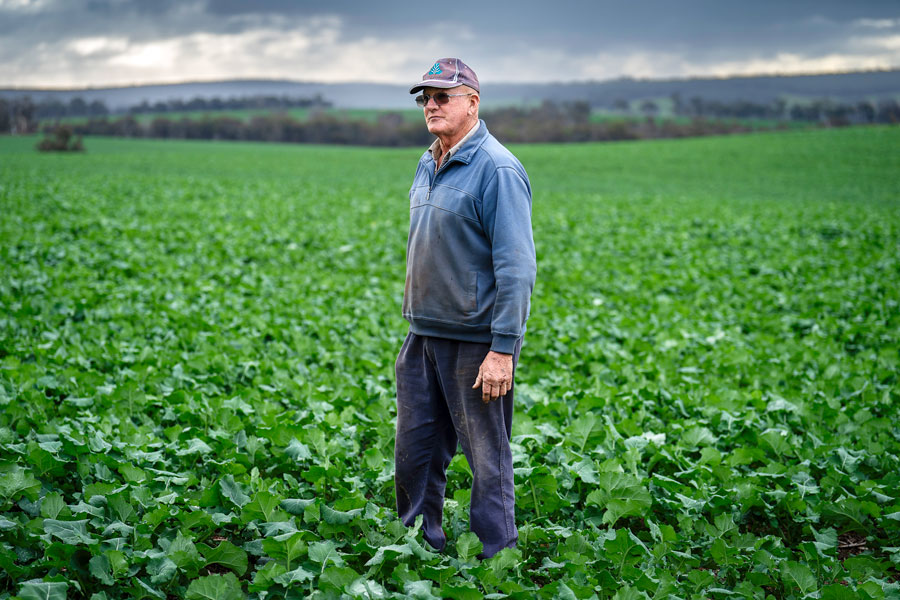Key points
- Ray Harrington has a long history of agricultural innovation driven by necessity and a desire to combat environmental challenges
- Collaboration and knowledge-sharing within the farming community are important to him as a means of improving practices and profitability
- Reflecting on the technological advancements, Ray says new technologies that reduce reliance on herbicides and address labour shortages in farming are important
Ray Harrington grew up with his mother’s oft-repeated adage, “Necessity is the mother of invention”, and this ethos has guided his farming operations.
Ray planted his 62nd crop this season and has gathered a wealth of experience over the years.
“My farming journey has been rich and rewarding,” he says. “But equally, it is rewarding being part of a community that shares ideas and expertise.”
Ray has just returned from a trip to South Australia, Victoria and New South Wales, where he visited growers who have adopted minimum tillage over the past 15 years. He says it was very encouraging to see what has transpired since the concept was introduced to eastern growers 30 years ago by Mike Glenn and Geoff Glenn from Agmaster, together with Steve King and Ray.
Ray and his brother David were early adopters of minimum tillage in the 1970s, a practice now widely adopted across Australia. Embracing the practice to combat water erosion on paddocks following ploughing, they needed a new seeding method and designed a knife-point system.
It is one of many Harrington innovations over the decades. Although effective, this system relies heavily on herbicides to control weeds.
“The evolution of farming systems, crop types and herbicides have gone hand-in-hand over the years,” Ray says. He notes that as these systems evolve, so do the weeds.
"We saw weeds adapting to the plough and being able to germinate from depth after burial. Then they adapted to various herbicides by developing resistance.” Ray says the key to control is constantly changing methods to keep the weeds off-guard.

Ray Harrington in a Roundup Ready® canola crop that was sown dry. Photo: Evan Collis
Observe and innovate
Ray farms 2450 hectares with his nephew, Tim Harrington, at Cordering, 190 kilometres south-south-east of Perth. The property has been in Ray’s family since 1973.
“Observation is a key skill in farming, both to monitor changes in your system and to look for new ideas and innovations to bring efficiencies to your operations,” he says.
Ray has a long-standing relationship with the GRDC-supported Australian Herbicide Resistance Initiative (AHRI) team. He closely monitors evolving weeds in his cropping system, using AHRI’s services to test for resistance. He has not detected any cases but stresses the importance of constantly mixing control methods to minimise resistance.
As a consummate innovator, Ray developed the first harvest seed destructor and seeded the idea of the weed chipper with Dr Michael Widderick from Queensland’s Department of Agriculture and Fisheries.
Having the destructor in the toolkit has stopped us from losing the war against weeds. There is no silver bullet for weed control, but adding many tools with at least 80 per cent effectiveness is a good way to keep weeds off-guard.
The Harringtons do not receive much summer rainfall in their region, so they have not observed the growth of many problematic annual weeds such as wild radish that can germinate all year round.
Recently, Tim and Ray took delivery of a new 140-foot (42.6-metre) spray rig fitted to a JCB Fastrac tractor custom-built in Wagga Wagga. Tim designed a nurse trailer to service the rig, which was also custom built.
“To suit the prevailing conditions and early time of sowing, we are dry sowing more of our crop. This unit, which was half the cost of a spray rig, enables us to cart up to 25,000 litres of spray water and improves our spray operation efficiencies by up to 70 per cent. It also has more utility as we can dismount the spray boom and tow the nurse trailer with it.”
No early rain this season meant Ray had to draw on other tools in his weed tool kit – Roundup Ready® canola.
“We swung our 2024 canola crop over to all Roundup Ready® to sow early and respond to the conditions.”
Collaborate
Ray says his recent trip to eastern Australia was about sharing the good, bad and ugly minimum tillage farming experiences and learning together. “We probably all learn even more from those bad and ugly experiences.”
Not only does Ray share his years of experience with growers, but he has also worked extensively with researchers to develop innovative machinery for the broader industry. “You need the science to underpin the innovations when you take them to market,” Ray says.
Over the decades, he has collaborated with many scientists from AHRI including Emeritus Professor Stephen Powles and Dr Michael Walsh. Ray also believes that having an advocate is crucial for bringing innovative equipment to market.
His network has extended to engineers, manufacturers, distributors and GRDC. “It also helps to have growers involved to ground-truth new equipment and ensure adoption.”
Looking to the future
Reflecting on his father’s farming experience, Ray notes the shift from horse-drawn equipment to high-powered mechanised equipment.
“We may not see the accelerated change that my father saw, but we will always see the desire for innovation in farming as new tools and ideas come onstream, especially if we continue to suffer from a shortage of labour.”
Technological innovations such as the targeted application of microwaves, steam or light-emitting diodes for selective spraying, and artificial intelligence, will present a step change for weed management, assisting in weed identification and in programming autonomous machinery, particularly for non-herbicide control.
“My balance sheet would look a lot better without herbicides,” Ray says.

























































